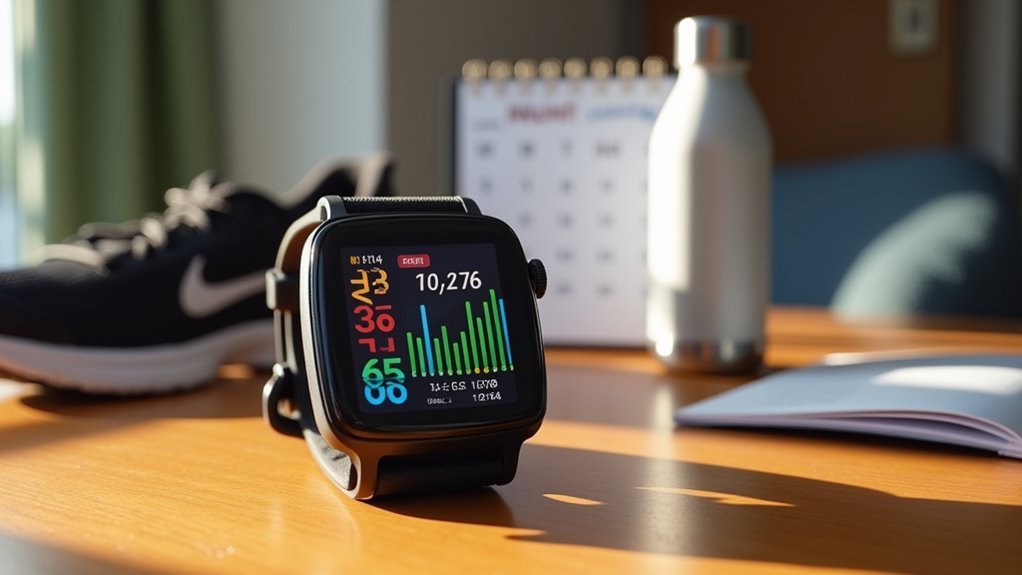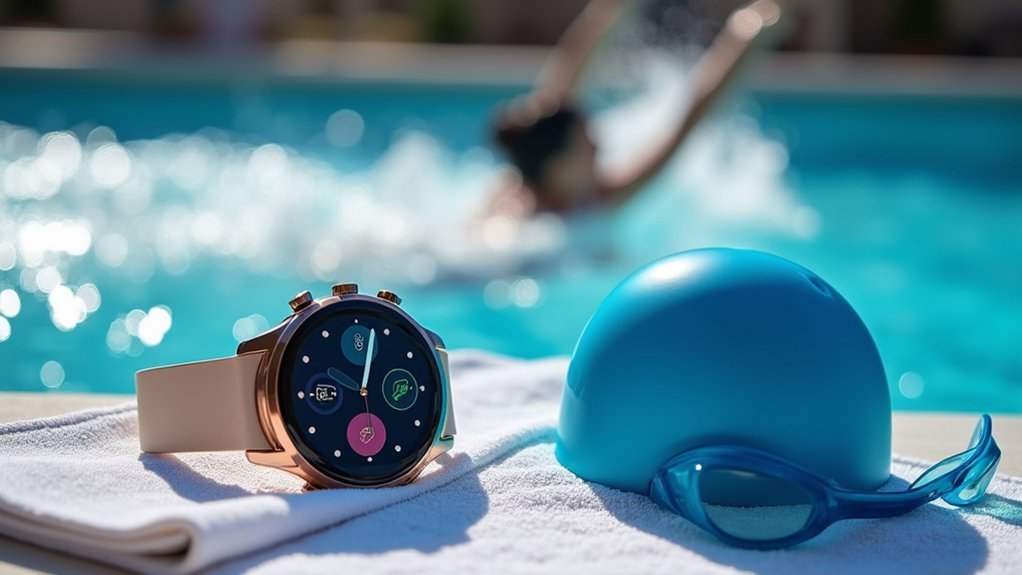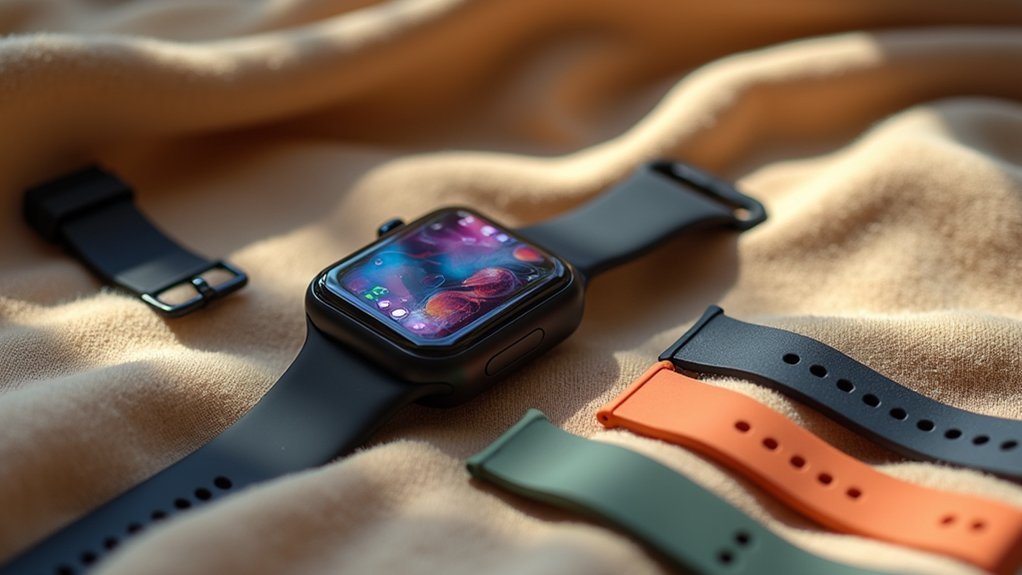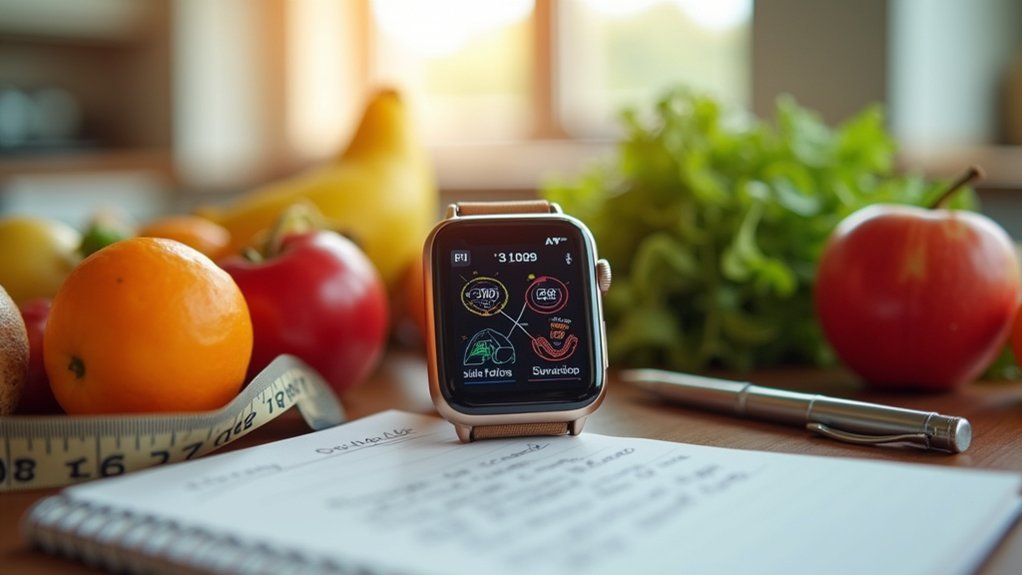When choosing a calorie-tracking smartwatch, prioritize GPS integration, compatibility with your smartphone, comfortable design, and realistic battery life. Consider subscription costs and understand that accuracy varies—wrist-worn devices may miscalculate by up to 100%. Look for multi-sensor integration, water resistance (minimum 5 ATM for swimmers), and heart rate variability tracking. Match band materials to your needs and guarantee proper fit for better measurements. The following tips will help you navigate beyond basic features to find your perfect fitness companion.
10 Tips: Find Your Perfect Calorie-Tracking Smartwatch
Why settle for a basic fitness tracker when today’s smartwatches can revolutionize your health journey? Look for devices with built-in GPS like the Fitbit Charge 5 to accurately track outdoor activities without carrying your phone.
Consider your smartphone’s operating system—Samsung Galaxy Watch 7 pairs best with Samsung phones, while Fitbit devices work across both iOS and Android.
For comfort during all-day wear, check out the Amazfit Balance or the Fitbit Charge 5. For fitness enthusiasts who enjoy outdoor activities, the Amazfit T-Rex 3 offers exceptional water resistance up to 328 feet.
Battery life matters too. The Fitbit Charge 5 offers up to 7 days between charges, ideal for tracking multi-day progress.
Don’t forget about subscription costs—Fitbit includes six months of Premium service, but you’ll pay afterward for advanced features.
Choose a water-resistant model like the Fitbit Charge 5 if swimming or water sports are part of your routine.
Understand Calorie Tracking Accuracy Differences
While wrist-worn trackers can miscalculate calorie burn by up to 100%, newer leg-worn sensors reduce this margin to about 14%.
You’ll notice daily fluctuations in your calorie readings depending on workout intensity, with Apple Watch accuracy improving during high-intensity exercise.
Rather than fixating on absolute numbers, focus on tracking consistent patterns in your calorie expenditure over time, which provides more actionable fitness insights than potentially inaccurate daily figures. Consider that WHOOP, unlike most trackers, does not count steps but instead focuses on strain from activity, providing a different approach to fitness measurement.
Compare Tracking Technologies
Four main sensor technologies power modern calorie tracking, each contributing differently to accuracy.
Optical heart rate sensors detect blood flow changes to estimate calorie burn, while accelerometers and gyroscopes measure movement intensity and patterns. GPS tracking adds precision for outdoor activities by calculating speed and distance. Some advanced devices also incorporate skin temperature sensors to refine metabolic calculations.
When shopping for your next fitness tracker, look for devices that combine multiple sensors rather than relying on a single data source. Multi-sensor integration greatly improves accuracy across different activities. Some devices like the Whoop 4.0 Band may overshoot heart rate metrics, affecting calorie burn calculations.
Remember that optical heart rate accuracy directly impacts calorie estimates—if your heart rate reading is off, your calorie count will be too. Premium devices typically offer more sophisticated sensor arrays and algorithms, delivering more reliable data for your fitness journey.
Daily Calorie Count Variations
Smartwatch accuracy isn’t just about the sensors—it’s equally important to understand your daily calorie count variations. Your calorie needs fluctuate based on gender, age, activity level, and weight management goals, with women typically needing 1,600-2,400 calories daily while men require 2,000-3,000.
Your lifestyle greatly impacts tracking precision. Physical labor demands more calories than desk jobs, while stress and poor sleep affect metabolism and eating patterns. Cultural preferences and meal structures also influence how calories distribute throughout your day. Understanding that not all calories carry equal nutrient value can help you make healthier choices when interpreting your smartwatch data.
For ideal tracking, choose a device that accommodates your unique patterns. Manual tracking introduces human error, while automated tools offer greater precision—though their accuracy depends on your input quality.
Regular updates and consistent usage will help your smartwatch adapt to your changing habits.
Accuracy Versus Consistency
Although perfect accuracy in smartwatch calorie tracking remains elusive, understanding the distinction between accuracy and consistency can transform how you use these devices.
Most wearables show errors exceeding 20%, with Garmins typically underestimating and Apple Watches overestimating calorie burn.
Rather than focusing solely on accuracy, consider these insights:
- Consistent tracking reveals meaningful trends even when absolute numbers aren’t perfect
- The same device used regularly provides valuable relative comparisons over time
- Your device’s heart rate and step count measurements are markedly more reliable (within 5% error)
- Individual factors like your metabolism, activity types, and body composition affect accuracy
- Using multiple health parameters together offers a more thorough fitness picture than calories alone
A 2022 study found that all tested fitness trackers demonstrated poor accuracy when measuring calorie burn across various types of physical activities.
Evaluate GPS Integration for Workout Precision
You’ll never miss your route again with modern GPS smartwatches that track your exact path during outdoor workouts.
Top models like the Garmin Fenix 7 and Apple Watch Ultra 2 use multiple satellite systems and dual-band technology to maintain accuracy even when running through tree-covered trails or between tall buildings.
For best results, position your watch with a clear view of the sky and choose a device with environmental interference compensation to guarantee you’re always on the right track. The Coros Pace 3 offers exceptional accuracy while maintaining a more affordable price point than premium alternatives.
Map Every Run
GPS accuracy forms the foundation of reliable calorie tracking during outdoor activities. When choosing a smartwatch, prioritize models with dual-band GPS and multi-system support to guarantee your workout data reflects reality, especially in challenging environments like urban centers or dense forests.
- Look for watches supporting multiple satellite systems (GPS, GLONASS, Galileo) for reliable positioning in obstructed areas.
- Consider Coros models for distance precision or Garmin for accurate elevation tracking based on your primary activities.
- Avoid wearing your watch under sleeves as clothing interference can disrupt satellite signals.
- Enable features like Suunto’s Snap to Route or Garmin’s ClimbPro when following planned courses.
- Remember that budget models often sacrifice multi-system GPS support, considerably reducing urban tracking accuracy.
Premium watches like the Polar Grit X2 Pro offer dual-frequency GPS capabilities that dramatically improve tracking accuracy compared to entry-level alternatives.
Hike Without Getting Lost
Reliable navigation during hikes demands more than basic GPS functionality—it requires a sophisticated integration of multiple tracking systems that work together to guarantee you stay on course.
Look for watches that combine multi-GNSS support (GPS, GLONASS, Galileo) with ABC sensors for thorough environmental awareness.
Before heading out, confirm your device has fully stabilized its signal—this typically takes 30-60 seconds in open areas.
For challenging terrain, choose models with offline map capabilities and breadcrumb navigation to maintain orientation even when signals weaken under dense canopy.
Battery management is vital; devices like the Garmin Instinct 2 Solar offer extended GPS tracking of up to 48 hours.
To maximize battery life on multi-day adventures, utilize interval tracking modes that balance position accuracy with power conservation.
Modern hiking watches like the Coros Vertix 2 provide exceptional water resistance up to 330m, ensuring performance reliability during river crossings or unexpected downpours.
Consider Battery Life for Your Activity Schedule

When selecting a calorie-tracking smartwatch, battery life becomes an essential factor that directly impacts your fitness monitoring routine.
Match your device’s power capacity to your specific needs to guarantee uninterrupted tracking.
- For daily intense workouts, choose devices like Fitbit Versa 4 with 6+ days of battery life.
- Marathon training demands watches with built-in GPS and extended battery, such as Fitbit Charge 5’s 7-day capacity.
- Withings smartwatches offer up to 30 days between charges, ideal for those who hate frequent recharging.
- Consider charging time—quick-charging models minimize downtime during active schedules.
- Look for power-saving features that detect when you’re not wearing the device to maximize battery efficiency.
The G-Shock Power Trainer provides excellent durability with its waterproof design making it suitable for various workout environments.
Remember that smartwatches with notification features typically have shorter battery lives, generally around 6 days.
Compare Smartwatch vs. Basic Tracker Features
Beyond battery considerations, you’ll face an important choice between full-featured smartwatches and simpler fitness trackers when selecting your calorie monitoring device.
Fitness trackers excel at health metrics with basic notification capabilities and longer battery life, typically lasting 5-7 days. They’re more affordable, compact, and ideal for 24/7 wear with their slim, discreet design. Many people find fitness trackers helpful for weight management as they support consistency in nutrition and training.
Smartwatches offer extensive functionality beyond calorie tracking – app support, messaging, calls, music control, GPS, and mobile payments. Their larger, interactive touchscreens provide richer information display and customization options.
However, this versatility comes with higher prices and shorter battery life.
Your decision depends on priorities: choose a fitness tracker if you want focused health tracking at lower cost, or invest in a smartwatch if you value connectivity and smartphone-like features on your wrist.
Assess Water Resistance for Swimming Activities

If you plan to track calories during swimming workouts, understanding your device’s water resistance rating is vital for both functionality and protection.
Look for watches with at least 5 ATM (50 meters) rating for proper swim tracking, while serious swimmers should consider 10 ATM or higher.
- Check for IPX8 certification alongside ATM ratings for extensive water protection
- Verify your watch includes water lock mode to prevent accidental touches while swimming
- Confirm whether the watch can track heart rate underwater—a significant metric for calorie calculations
- Consider your swimming environment—saltwater requires more robust protection than freshwater
- Look for swim-specific features like stroke recognition, lap counting, and SWOLF scoring
Remember to rinse your device with fresh water after each swim session to maintain its water resistance.
Many fitness trackers now evaluate your swimming efficiency scores to help you improve technique while optimizing calorie burn.
Examine Heart Rate Monitoring Capabilities
When choosing a calorie-tracking smartwatch, check its heart rate monitoring accuracy during high-intensity exercise, as many devices show 20% error margins when you’re pushing hard.
Consider whether you need continuous tracking for detailed calorie burn analysis or if interval measurements will suffice for your fitness goals.
Look for watches that offer recovery rate insights, which can help you understand your cardiovascular fitness and optimize workout intensity for better calorie management. Users with darker skin tones should research devices with improved sensors, as melanin absorbs more green light and can affect measurement accuracy.
Accuracy During Exercise
Heart rate monitoring capabilities vary greatly across different smartwatches and exercise conditions, directly impacting the accuracy of your calorie tracking.
Most devices perform well at rest but lose precision during higher-intensity workouts, especially above 150 bpm.
- Apple Watch typically underestimates by only 1.3 bpm and improves as intensity increases.
- Fitbit and Garmin show negative bias errors of approximately 3-5% across activities.
- Exercise type matters—running yields more accurate data than cycling due to consistent arm movement.
- Activating the correct activity mode on your device greatly improves tracking accuracy.
Chest-band devices provide more reliable readings compared to wrist-worn monitors since they measure electrical signals directly from the heart.
Calorie estimates can be off by up to 100%, so view these numbers as relative indicators rather than precise measurements.
Continuous Vs. Interval Tracking
The decision between continuous and interval heart rate monitoring greatly impacts the accuracy of calorie tracking on smartwatches. Continuous tracking captures every fluctuation throughout your day, providing the most precise calorie estimates and complete activity profiles. However, this comes at the cost of battery life. Photoplethysmography sensors are vital for delivering accurate heart rate measurements that directly inform calorie expenditure calculations.
| Feature | Continuous | Interval | Best For |
|---|---|---|---|
| Accuracy | High | Moderate | Continuous for athletes |
| Battery Use | High | Low | Interval for everyday wear |
| Data Detail | Complete | Partial | Continuous for health monitoring |
| Activity Capture | All moments | Scheduled checks | Interval for casual users |
When choosing your smartwatch, consider your priorities. If you’re training intensively or monitoring health conditions, opt for continuous tracking. For everyday fitness tracking with extended battery life, interval monitoring offers a practical compromise.
Recovery Rate Insights
Beyond the tracking frequency choice, your smartwatch’s ability to monitor recovery rates provides valuable fitness and health intelligence.
When evaluating a device’s heart rate monitoring capabilities, consider both accuracy and advanced features that interpret your body’s recovery signals.
- Look for devices with low error margins (under 10%) during both rest and exercise
- Choose smartwatches that measure heart rate variability (HRV) for better recovery insights
- Consider how well the device compensates for motion artifacts during intense workouts
- Higher-quality devices generally deliver more accurate readings, which justifies the investment
- Match features to your needs—casual users may not need the 99% accuracy that serious athletes require
Recent research shows that premium smartwatches like Apple Watch and Samsung Galaxy models provide 100% accuracy when measuring elevated heart rates during cardiac events like PSVT.
Remember that consistent wearing habits and proper fit greatly impact measurement accuracy, regardless of device quality.
Look for Sleep and Recovery Tracking Features
While tracking calories and workouts remains essential, sleep and recovery features have become equally important components in modern smartwatches. Choose a device that monitors multiple sleep stages—light, deep, and REM—along with interruptions that affect your rest quality. Comprehensive tracking through actigraphy and HRM provides the most accurate sleep data interpretation.
Today’s smartwatches prioritize recovery alongside activity—advanced sleep tracking has become as essential as counting steps.
Prioritize watches with heart rate variability (HRV) tracking, which reveals your nervous system’s recovery status. Blood oxygen (SpO2) monitoring can detect breathing issues during sleep, while wrist temperature sensors provide insights into your circadian rhythm.
Battery life matters—look for devices lasting over 18 hours to avoid charging during sleep.
The Oura Ring 4 offers exceptional comfort for overnight wear, while Apple Watch Series 10 and Garmin models provide extensive recovery metrics. For Android users, the Pixel Watch 2’s improved sensors deliver reliable sleep data.
Match Band Materials to Your Comfort Needs

Selecting the right band material for your calorie-tracking smartwatch goes beyond aesthetics—it directly impacts your daily comfort and device usability. Your lifestyle should guide your choice to guarantee consistent wear for accurate calorie tracking.
- Silicone/rubber bands excel for workouts with their water resistance and easy cleaning after sweaty sessions.
- Nylon/fabric straps offer breathability for all-day comfort, though they’ll need drying after intense activities.
- Leather bands provide professional style for office wear but require maintenance and aren’t ideal for heavy exercise.
- Metal bands deliver durability and sophistication but may feel heavy during long workouts.
- Ceramic options suit sensitive skin with hypoallergenic properties while maintaining a premium look.
Active individuals should consider nylon NATO straps as they prevent watch case contact with skin, reducing irritation during extended tracking periods.
Choose materials that match your primary activities to maximize comfort and tracking consistency.
Analyze App Compatibility With Your Ecosystem
Understanding app compatibility in your smartwatch ecosystem can make or break your calorie-tracking success. Check your device’s OS requirements—Apple Watches need watchOS 9+ (Series 4 and newer), while Android watches require WearOS 3.0+ for full functionality.
Before diving into fitness apps, ensure your smartwatch meets the minimum OS requirements for complete calorie-tracking functionality.
Consider how apps sync across your devices. MyFitnessPal integrates seamlessly with Apple Watch, but Android users might face limitations with certain fitness platforms. For Apple Watch users, MyFitnessPal requires WatchOS 6.0 or later for optimal performance. Remember that most setups require installing companion apps on both your phone and watch.
Look for apps that support extensive health tracking beyond just calories—including workout logs, sleep data, and meal tracking—to create a cohesive health monitoring system.
Pay attention to notification capabilities and cross-device syncing speed, which vary considerably between ecosystems and can affect how efficiently you track your daily calorie balance.
Frequently Asked Questions
Can Calorie Tracking Affect Users With Eating Disorders?
Yes, calorie tracking can worsen your eating disorder symptoms. Research shows it’s linked to increased disordered behaviors, obsessive thoughts, and feelings of failure. If you’ve struggled with eating disorders, consider more balanced monitoring approaches instead.
How Accurate Are Smartwatches for Weight Lifting Calorie Estimates?
Smartwatches are quite inaccurate for tracking weight lifting calories. They can underestimate by 69% or show errors up to 58%. You’ll get better results by keeping your biometrics updated and wearing your watch snugly.
Do These Devices Work Accurately for Wheelchair Users?
Smartwatches aren’t very accurate for wheelchair users. You’ll face significant errors in calorie tracking, with devices like Fitbit showing up to 74% error rates. Apple Watch performs better for push counts but still has limitations.
Can I Track Calories Without a Subscription Service?
Yes, you can track calories without a subscription. Many budget and mid-range smartwatches offer free calorie tracking using heart rate and movement sensors. The estimates won’t be perfect, but they’re available without monthly fees.
How Do Altitude and Temperature Affect Calorie Tracking Accuracy?
Higher altitudes increase calorie burn due to higher metabolic rate, while temperature affects how hard your body works. Most smartwatches can detect altitude but rarely adjust for temperature, affecting tracking accuracy by 20-60%.
In Summary
When you’re ready to buy your calorie-tracking smartwatch, remember that the perfect device fits your unique lifestyle. Don’t sacrifice what matters most to you—whether that’s accuracy, battery life, or comfort. Take time to test different options before committing. With the right smartwatch on your wrist, you’ll have a powerful tool that supports your health journey every step of the way.





Leave a Reply